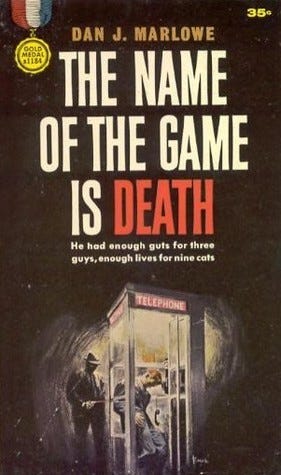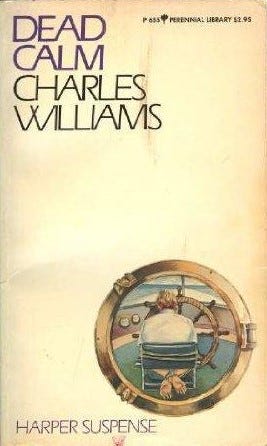C&C 2: The Shady Side of the Sixties, Part One
1960s crime fiction goes upmarket thanks to Library of America
Some crime fiction demands to be read in cheap paperbacks with lurid covers. But when given the opportunity to take a sneak peek at Library of America’s upcoming Crime Novels collection, covering the 1960s in two volumes to be published in September 2023, I wasn’t about to stand on ceremony.
The previous LOA Crime Novels compendiums have a place of honor on my shelf, the 1930s and ‘40s covered in a single book, the ‘50s in another. Edited by poet and author Robert Polito, these anthologies include landmarks of the genre like James M. Cain’s The Postman Always Rings Twice (1934); William Lindsay Gresham’s Nightmare Alley (1946); Jim Thompson’s The Killer Inside Me (1952); and Patricia Highsmith’s The Talented Mr. Ripley (1955). The titles collected in the bifurcated follow-up, with editing duties assumed by Geoffrey O’Brien, may not have spawned as many movie adaptations, but the deeper cuts served in this smorgasbord offer the full range of the decade’s flavors as crime fiction boldly pushed into new terrain.
Sure, it’s a touch disconcerting to read (or reread) such nastiness in a handsomely-produced LOA hardcover. On the other hand, you won’t need the tasteful ribbon bookmark sewn into the binding. These are brief, propulsive novels, the kind you can bolt down in a single sitting, but still brimming with suspense and psychological insight.
First, an overview of the book covering 1961 to 1964.
Things get off to a raucous start with The Murderers (1961), a perfect introduction to the corkscrew sensibility of author Fredric Brown. Willy Griff is an actor scuffling on the fringes of Beat-era Los Angeles who’s more interested in booze and broads than his craft. Brown depicts the seedy milieu so brilliantly that when Willy casually says, “I had some money coming from a bit on The Untouchables (I’d played a technician in a police laboratory),” I was certain that at one point he’d cracked open a bottle of musky with Rick Dalton.
Willy’s seeing a married woman, but her husband gets wise and puts a stop to their fun. Or so he thinks. What follows is the classic noir set-up—lovers conspiring to bump off an inconvenient spouse—only with a twosome of lazy Hollywood hangers-on who don’t have their hearts in the plot but manage to back into mayhem anyway. Brown’s sly sense of humor is on display throughout, which makes the novel’s astonishingly dark turns even more shocking. Read it for the tremendous atmosphere, but don’t read the doozy of an ending on an airplane, as I did. You’ll be cackling so hard that your seatmates may start discreetly signaling the flight attendant. Easily my favorite of the entire collection.
Dan J. Marlowe’s life—complete with amnesia, a spanking fetish, and a stint rooming with one of the FBI’s Ten Most Wanted—is something out of pulp fiction. He’d likely be surprised to find himself rubbing shoulders with his fellow LOA authors. Willa Cather and Booth Tarkington might want to check their valuables but Marlowe belongs in their company, given that with The Name of the Game is Death (1962) he wrote the quintessential Gold Medal paperback. As a criminal sets out to retrieve the loot from a bank job, he flashes back to the incidents from his life that shaped him. The result is a slow-burn revenge yarn that doubles as a hardboiled case study. Take it from the unnamed protagonist’s first cellmate, a lifer called Doc: “‘Life is the big machine, kid,’ he’d growl at me in his after-lights-out rasp. ‘It chews you up and it spits you out. Don’t you ever forget it.’” Fun fact: much of the action plays out in Hudson, Florida, just up US Highway 19 from the town where I attended high school against my will. Marlowe later rewrote the book to create a series, transforming his unrepentant recidivist into a government operative (Drake: The Man with Nobody’s Face) just in time for Watergate. LOA presents the original text in all its gut-punch glory.
Charles Williams’s maritime thriller Dead Calm (1963) is the best-known title in the collection, adapted into the 1989 film that starred Sam Neill and introduced Nicole Kidman to global audiences. Honeymooners on an ocean voyage (the couple first introduced in Williams’s 1960 novel Aground) encounter a sinking ship and rescue the sole apparent survivor. But all is not as it appears. The novel is stronger than the film, with Williams’s extensive experience as a sailor ratcheting up the intensity. Still, he lays on the psychology regarding the interloper a little thick. Orson Welles originally owned the film rights and never finished his version, in which he appeared opposite Laurence Harvey and Jeanne Moreau. What I wouldn’t give to see that.
One of the many virtues of this collection is that it might introduce more readers to Dorothy B. Hughes (Ride the Pink Horse, In a Lonely Place), who deserves to be celebrated as one of the prime practitioners of noir. In her final novel, The Expendable Man (1963), Hugh Densmore, a young doctor driving to a family wedding in Phoenix, picks up a hitchhiking girl in the California desert. He comes to regret this act of kindness. The girl is later found dead. Only then does Hughes reveal a piece of information that alters what has come before and molds what is to come. For a hot-button novel touching on abortion and race, The Expendable Man has an unusually cool and steady pulse. Densmore must maintain his composure as he’s plunged into a nightmare, dogged by a friendly-seeming local marshal only interested in avoiding a media circus and a pair of homicide dicks, one of whom “with more hate for an innocent Hugh than for a guilty.” You’ll sweat all the way through, and not only because of the desert heat. As Densmore observes, “People were nice if you found the right ones. The trouble was there were so many of the wrong ones.”
The novel I’ve read the most in this volume is the one about which I have the least to say. You can never go wrong with any of the books by Richard Stark, pen name of Donald E. Westlake, about the icy professional thief Parker. In The Score (1964), Parker assembles a team to knock over an irresistible target: an entire town. It serves as the introduction for Alan Grofield, the stage actor who’d rather pull jobs than wait tables and who’d star in his own string of novels.
Coming soon: a review of Volume 2.
What (Else) I’m Reading
Sally Jenkins’s Washington Post article about the decades-long rivalry/friendship between Chris Evert and Martina Navratilova is as good as advertised.
From this New Yorker story by Alex Barasch on the upcoming Barbie movie and Mattel’s efforts to Marvelize Hollywood comes this chilling speculation from an agent:
“Is it a great thing that our great creative actors and filmmakers live in a world where you can only take giant swings around consumer content and mass-produced products?” he said. “I don’t know. But it is the business. So, if that’s what people will consume, then let’s make it more interesting, more complicated.” He wondered aloud whether such directors as Hal Ashby and Sydney Pollack would be making movies with Mattel if they were alive today: “It’s a super-interesting question. It’s also an argument that we’ve lost already.”
Jason Diamond’s post about an 86’d essay on the sandwich from the Kevin Kline movie Dave says a lot about the lot of the freelance writer and the sandwich from the Kevin Kline movie Dave. I watched Dave again just to see it.








I was introduced to Parker through Darwyn Cooke's beautiful adaptations. Later I bought the novels and read them side by side. What a blast.
When I started reading The Expendable Man I kept thinking "What is this guy so worried about?"
Yes. Vince!! Yes.